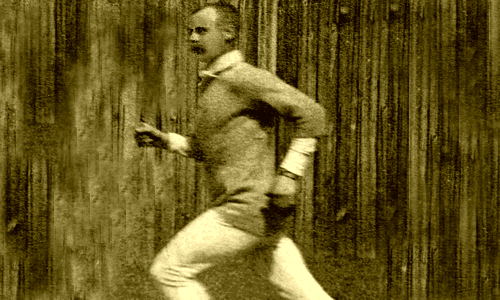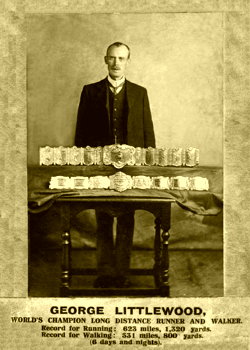King of Pedestrianism

George Littlewood was born on 20 March, 1859, in Rawmarsh, Yorkshire, England. This phenomenal athlete, who is already being talked about as probably being the greatest ultra long-distance foot athlete the world has ever seen, was to become a sporting superstar of his day travelling over to America on several occasions, where, at Madison Square Garden, New York, in 1888, he produced a scintillating performance to beat the then current six-day world record of 621¾ miles held by the American, Jimmy Albert, by running another two miles on the 8-lap to the mile sawdust track. The 623¾ miles he made that week that wasn't beaten for 96 years was just one of his amazing achievements; one of which is still being the current owner of the 6-day walking record from 1882!
So what made Littlewood tick and where he did he get his inspiration from? It was at the age eight that he began showing an aptitude for running whilst chasing the hounds in local hunts. He also excelled in other sports including boxing, wrestling and cricket, but it was in the field of athletics, and, in particular, running, which he displayed a real talent for.
His father Fred, a handy handicap runner himself, knew his son was something "special" and took on the task of training him seriously. The regime he fashioned for him was both daunting and vigorous, and when the boy complained to his dad that his muscles were sore one day, his dad offered him the carrot of a financial reward. "If you can catch me, you can have this halfpenny. If you really want it, you can get it," he told his son. His father set off and the lad went after him. When the boy caught him up and passed him, he was given his prize for his effort. George had proved to himself that he could overcome the pain barrier to reach his goal and that experience would prove valuable for his future career.
Littlewood's dedication to perfection in the art of race walking soon paid off when, at the age of 16, he won his first long distance event and was given a silver cup donated by several Sheffield publicans. A judge at the time said this of the lad as he performed on the track: "He is completely genuine, without any deviation from the strict laws of walking."
Littlewood's preparation during the next four years involved both running and walking over 200 miles a week. He would train by running to Doncaster and back three times a week in a 38-mile round trip. On his arrival in Doncaster, he would call into a local butcher where he would buy mutton which he would run back home to Darnall with. There were reports that he had a food fetish and that his mum used to go to his races and cook for him to see that he ate properly! One of his trainers Fred Bromley said of him: "If you want to raise a lot of steam and power, you must stoke the coals on the fire!"
In November, of 1879, Littlewood starred in his first race as a budding long-distance athlete in a six-day, 72-hour, 12 hours per day, "go-as-you-please" event in which he came in fourth of 28 contestants winning a prize of £4 for scoring 275 miles in the allotted time on a 19-lap to the mile track at Wolverhampton.
He then went Nottingham, in February, of 1880, where, in a 7-day, six hours per night contest, he came in 5th of 19 runners winning £2.
A couple of months later, he went to Leeds where he won his first race in a field of 13 contestants and created a new 12 hours per day, 72-hour world record of 374 miles on an 38-lap to the mile track in a circus rink. For winning, he secured the £35 first prize — plus an extra prize of £10 for beating the record. Littlewood would later remark that this was the greatest race he ever won.
His next event which was his first venture to London, where in September of the same year, and competing in field of 29 at the Agricultural Hall, Islington, he won the Sir John Astley, "Champion Gold Medal" and a prize of £60, which included £10 for beating the then world record of 405 miles.
Now established as an up-and-coming figure in his chosen sport, his connections entered the then 21-year-old into the 6th international version of the Astley Belt — the blue riband 142-hour, six days, "go-as you-please" contest again at the "Aggie". He would be up against the reigning long-distance champion — the formidable Charlie Rowell — a man, who only the year before at Madison Square Garden, New York, had secured phenomenal prize money of $50,000 in two races in that city. During the race, in which he finished as runner-up with a score of 470 miles, George also took on the great "Blower" Brown of Fulham, and some very good American athletes.
 Littlewood then went over to the U.S.A. for the first time to compete in the "2nd O'Leary International Belt" contest at Madison Square Garden, in 1881. Although starting the favorite, Littlewood only managed to make 480 miles due to a foot injury.
Littlewood then went over to the U.S.A. for the first time to compete in the "2nd O'Leary International Belt" contest at Madison Square Garden, in 1881. Although starting the favorite, Littlewood only managed to make 480 miles due to a foot injury.
Then in 1882, between March 6 and 11, Littlewood achieved the unthinkable. Not only did he beat the then 142-hour heel-and-toe world walking record of 530 miles, he still holds it! The 531 miles was made on a 13-lap to the mile track at the Norfolk Drill Hall, Sheffield.
He then competed in the 1st, 2nd, 3rd, 4th and 5th "Astley Challenge Belt" races. The belt was the prize for winning the 12 hours a day, 72 hours per week version of the "Long-Distance Astley Belt" and the events took place in Birmingham, Sheffield and London between April of 1882 and November of 1884. Littlewood would eventually win the belt outright.
In 1883, he also raced against a horse called Charlie in a 17-mile race from Doncaster to Sheffield. He lost by three quarters of a mile.
After that, and in April of 1885, Littlewood took on Rowell again in the "International Pedestrian Tournament" (won) and then again in February of 1887 in the "International Pedestrian Go-As-You-Please Tournament"; both races being held at the Westminster Aquarium, London.
After those races he went back to America for the second time; firstly to Philadelphia where he annihilated the opposition in November of 1887 in the "Championship of the World Sweepstakes" before returning to New York to compete in his last two races at Madison Square Garden in May and December of the following year, 1888.
The May race saw Littlewood breaking the 600-mile barrier despite running on a raw bone in his foot and when he brought the Fox Diamond Belt back from America to England, they called him "Littlewood the Lionheart".
In 1966, and referring to his 1888 world record, a physiologist, B. B. Lloyd, writing in Advancement of Science, described Littlewood's feat as "probably about the maximum sustained output of which the human frame is capable".
George Littlewood died on the December 4, 1912. His funeral was attended by 3,000 people.
Credits - WorldwideRunning.com would like to thank the website KingOfThePeds.com (www.kingofthepeds.com) for the authorization to reprint the article "King of Pedestrianism" by Paul S. Marshall. George Littlewood career is fully covered in "King of the Peds" by Paul S. Marshall.

